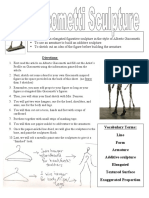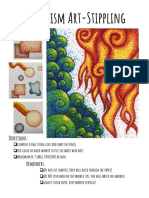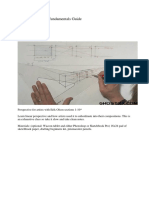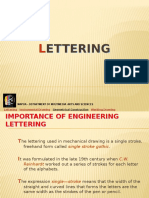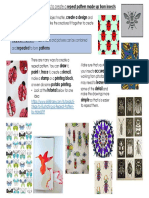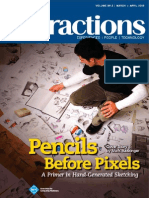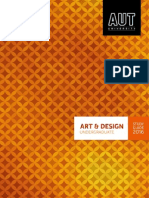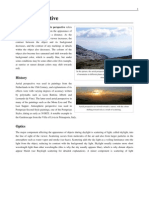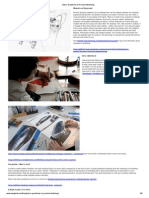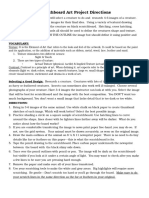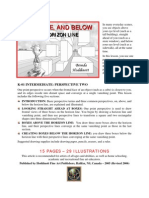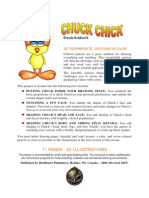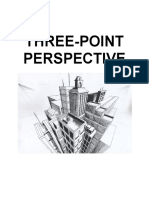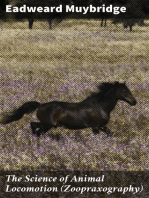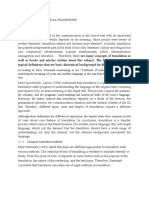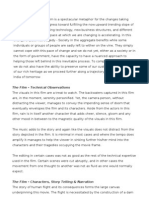Figure Drawing
Figure Drawing
Uploaded by
Krishna DhyaniCopyright:
Available Formats
Figure Drawing
Figure Drawing
Uploaded by
Krishna DhyaniOriginal Description:
Copyright
Available Formats
Share this document
Did you find this document useful?
Is this content inappropriate?
Copyright:
Available Formats
Figure Drawing
Figure Drawing
Uploaded by
Krishna DhyaniCopyright:
Available Formats
FIGURE STUDY DRAWING
You will investigate the elements and principles of design: proportion, line, shape, form, value and space as they apply to the human figure. STEP ONE: You will select
one photocopy reproduction of a Greek or Roman Classical figure to reproduce on a large 18 x 24 piece of paper.
NAME:_____________
STEP TWO: Begin by
outlining the figure lightly with your pencil. REMEMBER: Consider the proportions of the entire figure (body, head, legs, arms etc.)
DO NOT RUSH YOUR OUTLINE: Once you begin
adding value and shading to your figure it is difficult to change the proportions.
STEP THREE: Once you
believe the proportion of the outline of the figure are accurate begin by adding value and shading to the figure (light to dark tones) to create a sense of three-dimensionality to the form. While adding value and shading consider the direction of your light source. The light and dark areas of your figure should have a variety of both extreme light and dark areas.
Discus Thrower (Discobolus), Roman copy of an original bronze by Myron (Hellenistic Greek, c. 485 - c. 425 BCE).
STEP FOUR: REFLECT:
Answer the following questions using the elements and principles of design and hand them in with your completed drawing(s) for evaluation. 1. What part of your finished project did you find most successful and why? 2. What part of your finished project did you find least successful and why? 3. If you had to do this project, what part would you change or improve on and why?
Close Up, Seated Boxer.
Seated Boxer, Greek bronze, 3rd century B.C.E.
Figure Study Drawing Rubric
Achievement Criteria Level 0 Level 1 Level 2 Level 3
Name:__________
Level 4
Thinking/ Inquiry
Concept & Meaning:
Work does not meet assignments expectations for this category. Incomplete.
Concept is unclear and/or weak. Meaning or ideas conveyed are not on par with student grade level.
Concept is slightly unclear and/or weak. Meaning or ideas conveyed are below expectations for students grade level. Applies some of the elements & principles of design while composing work.
Concept is clear and valid. Meaning or ideas conveyed are on par with students grade level. Applies considerable elements & principles of design while composing work.
Concept is clear and strong. Meaning or ideas conveyed are above expectations for students grade level. Applies substantial elements & principles of design while composing work.
/2
0.5 0
Work does not meet assignments expectations for this category. Incomplete. Composition is unbalanced. Little thought has been given to the placement of elements & principles on the page, or to the correct ratio of positive to negative space. Composition is semibalanced. Some thought has been given to the placement of elements & principles on the page and the correct ratio of positive to negative space. Composition is mostly balanced. Adequate thought has been given to the placement of elements & principles on the page and the correct ratio of positive to negative space. Composition is balanced. Much thought has been given to placement of elements & principles on the page and the correct ratio of positive to negative space.
0.5 - 1.0
1.0 - 1.75
Knowledge/ Understanding
Composition
/1
0.5 0.25 0
0.75
Application/ Creation
Value (Shade & Tone)
Incomplete.
Work demonstrates no areas of extreme black or white. The composition does not contain sufficient value to reflect three dimensionality.
Work demonstrates few areas of extreme black or white. The composition is grey overall or contains minimal value to reflect three dimensionality.
Work demonstrates some areas of extreme black or white. The composition contains sufficient value to reflect three dimensionality.
2 1
3-4
Work demonstrates exact and balanced amounts of extreme blacks, whites & greys. The composition contains balanced value to reflect three dimensionality.
/5
5 Process: Demonstration of Skill Development & Following Procedures including Clean Up
Work does not meet assignments expectations for this category. Incomplete. Student demonstrates limited effectiveness in demonstrating the process of following procedures and skill development. Student demonstrates some effectiveness in demonstrating the process of following procedures and skill development. Student demonstrates considerable effectiveness in demonstrating the process of following procedures and skill development. Student demonstrates superior effectiveness in demonstrating the process of following procedures and skill development.
/10
6 - 6.5 5 7 - 7.5 8 - 10
0 Completion/ Neatness
Incomplete.
/5
0
The submitted work appears obviously incomplete. Much more effort could have been included: time has obviously been mismanaged. The submitted work appears slightly incomplete. Some additional effort could have been included: time has been slightly mismanaged. The submitted work appears slightly incomplete. Some additional effort could have been included: time has been slightly mismanaged. The submitted work appears slightly incomplete. Some additional effort could have been included: time has been slightly mismanaged.
2 1 Detail
Work demonstrates limited detail. Incomplete. Work demonstrates some detail.
3-4 5
/5
Work demonstrates substantial detail. Work demonstrates exemplary detail.
3-4 2 1 0
Incomplete.
Communication
Clarity & Accuracy: Proportions, Lines & Forms 0
Incomplete.
Work demonstrates limited degree of clarity and accuracy in proportions, line and form.
Work demonstrates some degree of clarity and accuracy in proportions, line and form.
Work demonstrates considerable degree of clarity and accuracy in proportions, line and form.
Work demonstrates high degree of clarity and accuracy in proportions, line and form.
/5
2 1
3-4
Answers are clear and complete.
/2
0
Answers are vague/incomplete. Answers are somewhat clear and complete.
1.0 - 1.75 0.5 - 1.0
Answers are clear & exemplary.
Reflection Questions 2 0.5
/35
A1. The Creative Process: apply the creative process to create a variety of art works, individually and/or collaboratively; A1.2 use experimentation, reflection, and revision when producing a variety of art works in each of the following areas: drawing, sculpture, painting, printmaking, and mixed media (e.g., experiment with a variety of materials/media, techniques, and tools to find ones that are appropriate for their planned art work; reflect on their preliminary work and on feedback from their peers before revising their art work) A1.3 document their use of the creative process in a portfolio (e.g., include evidence of their conceptual, creative, and technical skills; include thumbnail sketches, checklists, and/or graphic organizers to show evidence of experimentation, reflection, and revision), and refer to this portfolio to reflect on how effectively they have used the creative process
A2. The Elements and Principles of Design: apply elements and principles of design to create artworks for the purpose of self-expression and to communicate ideas, information, and/or messages; A2.2 apply elements and principles of design as well as art-making conventions to create art works that communicate ideas, information, or messages, and/or that convey a point of view on an issue A3. Production and Presentation: produce art works, using a variety of media/materials and traditional and/or emerging technologies, tools, and techniques, and demonstrate an understanding of a variety of ways of presenting their works and the works of others. B1. The Critical Analysis Process: demonstrate an understanding of the critical analysis process by examining, interpreting, evaluating, and reflecting on various art works; B1.2 identify and describe the elements and principles of design used in their own art works and the works of others, and describe their effects (e.g., how line, colour, and shape are used to create emphasis, mood, and/or movement) B1.3 explore and interpret a variety of art works, both historical and contemporary, to identify and describe their purpose and style, the materials used, and the meanings the works convey B1.4 use a variety of strategies (e.g., peer- and self-assessment, formal critiques, feedback and reflection following public displays) to identify and reflect on the qualities of their own art works and the works of others, and evaluate the effectiveness of these works B2. Art, Society, and Values: demonstrate an understanding of how art works reflect the societies in which they were created, and how they can affect personal values; B2.1 identify and describe the function of various types of art works in past and present societies C1. Terminology: demonstrate an understanding of, and use correct terminology when referring to, elements, principles, and other components related to visual arts; C1.1 use appropriate terminology related to elements and principles of design when creating and analysing art works C1.2 use appropriate vocabulary to describe techniques, materials, and tools when creating and presenting visual art works (e.g., dry brush; layering; pinhole camera; washes; techniques and tools used to create flipbooks, illuminated manuscripts, mosaics, stained glass works) C1.3 identify and describe the stages of the creative process and the critical analysis process (e.g., how reflection relates to the other stages of the creative process) C2. Conventions and Techniques: demonstrate an understanding of conventions and techniques used in the creation of visual art works; C2.1 demonstrate an understanding of a variety of techniques that artists use to achieve specific effects (e.g., the use of atmospheric perspective to create the perception of depth, the use of additive and subtractive sculpture to explore space and form, the use of layering to provide a sense of dimensionality) C2.2 demonstrate an understanding of several conventions used in visual art works (e.g., exaggeration, metaphor, simile, symbols, synectics; conventions associated with heroic, narrative, naturalistic, and satirical works) C3. Responsible Practices: demonstrate an understanding of responsible practices in visual arts. C3.2 demonstrate an understanding of safe and conscientious practices associated with the use of materials, tools, and technologies in visual arts, and apply these practices when creating and/or presenting art works (e.g., use appropriate precautions when dealing with hazardous materials; adopt protective measures when using sharp tools; keep their work space clean and free of physical and other hazards; demonstrate respect for classroom facilities, tools, equipment, and technological devices)
You might also like
- Clay Gargoyles Lesson PlanDocument2 pagesClay Gargoyles Lesson PlanspektorishNo ratings yet
- Natural FormsDocument50 pagesNatural Formsapi-240876812No ratings yet
- Form BuildingDocument21 pagesForm BuildingBhuvnesh TenguriaNo ratings yet
- Santa Muerte RosaryDocument2 pagesSanta Muerte Rosaryserpentfhs0% (1)
- Scenario 2. ReflectionDocument5 pagesScenario 2. ReflectionShafiq Ur Rahman50% (2)
- Giacometti Sculpture HandoutDocument2 pagesGiacometti Sculpture Handoutapi-260853196No ratings yet
- Value Still LifeDocument1 pageValue Still Lifeapi-417919455No ratings yet
- Sketchbook PointillismDocument2 pagesSketchbook Pointillismapi-276367635No ratings yet
- The Scarlet Letter - BookDocument125 pagesThe Scarlet Letter - BookDiana CavasdanNo ratings yet
- Sense of BelongingDocument3 pagesSense of BelongingJewoNo ratings yet
- End of 2nd Semester Writing Rubric Grade 12 - (Short Writing - Functional)Document1 pageEnd of 2nd Semester Writing Rubric Grade 12 - (Short Writing - Functional)anouar_maalej3624No ratings yet
- Benhabib-The Embattled Public SphereDocument25 pagesBenhabib-The Embattled Public SpherevincenzomarazziNo ratings yet
- Drawing Architecture: An Interview With David MacaulayDocument4 pagesDrawing Architecture: An Interview With David MacaulayminoasNo ratings yet
- Drawing Exercise MemoryDocument6 pagesDrawing Exercise MemoryAnonymous 4oVLhGRNo ratings yet
- Draw Better SampleDocument26 pagesDraw Better SampleSimona DumitruNo ratings yet
- 8 FD - Week 1 - Adonis CaraDocument15 pages8 FD - Week 1 - Adonis CaraRamlede Benosa100% (1)
- Observational DrawingDocument16 pagesObservational Drawingapi-279660401No ratings yet
- History of Design - Sample Course OutlineDocument2 pagesHistory of Design - Sample Course OutlineRicha PantNo ratings yet
- 2 Freehand SketchingDocument8 pages2 Freehand SketchingMa'am FhatzNo ratings yet
- AguriDocument9 pagesAgurikaiNo ratings yet
- From The 'Sketchpad' To 'Sketching' - Contextualising 'Processing': The Programming Language For Artists and Designers .Document106 pagesFrom The 'Sketchpad' To 'Sketching' - Contextualising 'Processing': The Programming Language For Artists and Designers .Hemant Sreekumar100% (1)
- Art Fundamentals SyllabusDocument4 pagesArt Fundamentals Syllabusapi-496209170No ratings yet
- Lettering Lecture - Powerpoint - PPSXDocument19 pagesLettering Lecture - Powerpoint - PPSXJames Philip Gaddi0% (1)
- IllustrationDocument2 pagesIllustrationapi-362784633No ratings yet
- Drawspace-2 1 R01Document7 pagesDrawspace-2 1 R01Artur da Gloria100% (1)
- Unit 3 4 Studio Art Exploration ProposalDocument8 pagesUnit 3 4 Studio Art Exploration Proposalapi-340277232No ratings yet
- Year 7 Bugs Lesson 5Document1 pageYear 7 Bugs Lesson 5api-293503824No ratings yet
- Baskinger Pencils PixelsDocument11 pagesBaskinger Pencils PixelsLuisina Gutierrez100% (1)
- Week 6 PerspectiveDocument52 pagesWeek 6 PerspectiveJJ PonsicaNo ratings yet
- A Beginners Guide To Digital Textile PrintingDocument16 pagesA Beginners Guide To Digital Textile PrintingJessica HibbertNo ratings yet
- Drawing-Human FigureDocument9 pagesDrawing-Human FigureS Sinha RayNo ratings yet
- 2016 Art & Design Undergraduate Study GuideDocument40 pages2016 Art & Design Undergraduate Study Guidemwaseem2011No ratings yet
- Setting Up A Creative Space: Choosing A Comfortable Chair and Drawing SurfaceDocument3 pagesSetting Up A Creative Space: Choosing A Comfortable Chair and Drawing SurfaceTabita IonescuNo ratings yet
- Perspective Project SheetDocument1 pagePerspective Project Sheetapi-323978082No ratings yet
- Linear and Aerial PerspectiveDocument8 pagesLinear and Aerial PerspectiveAbdul Ghafoor BhattiNo ratings yet
- 05 Composition Viewfinder Worksheet d1Document5 pages05 Composition Viewfinder Worksheet d1api-258238272No ratings yet
- Aerial PerspectiveDocument4 pagesAerial PerspectivegalegatorNo ratings yet
- How To Draw A Semi Realistic CharacterDocument12 pagesHow To Draw A Semi Realistic CharacterLars Christevandersson100% (1)
- Basic Design 1Document24 pagesBasic Design 1Nupur MishraNo ratings yet
- Basic Guidelines To Product SketchingDocument4 pagesBasic Guidelines To Product SketchingOlajide DI0% (1)
- B 09Document0 pagesB 09Daniela Alexandra DimacheNo ratings yet
- The Art of Illustrating Children's BooksDocument9 pagesThe Art of Illustrating Children's BooksScribdTranslationsNo ratings yet
- Scratchboard Art Project DirectionsDocument3 pagesScratchboard Art Project DirectionsDJacobson100% (2)
- Unit 2 Otcome 1 Vce RubricDocument2 pagesUnit 2 Otcome 1 Vce Rubricapi-246589904100% (1)
- One Point and Two Point Perspective Worksheet PacketDocument20 pagesOne Point and Two Point Perspective Worksheet PacketAsia Winter-Sinnott100% (1)
- How To Draw A Train Full Guide EasyDrawingGuides - Com HDT 00126Document7 pagesHow To Draw A Train Full Guide EasyDrawingGuides - Com HDT 00126uthayaNo ratings yet
- Menu Painting 2Document2 pagesMenu Painting 2api-264492115No ratings yet
- Monster Hunter StoriesDocument22 pagesMonster Hunter Storiespetrus.suparjanNo ratings yet
- On - Above, and Below The Horizon LineDocument15 pagesOn - Above, and Below The Horizon LinekabadahijaNo ratings yet
- GouacheDocument3 pagesGouachecuatro sharedNo ratings yet
- "Wire Silhouette Figure Sculptures" Grade: Fifth Project Length of Time: 2 Art Sessions NYS StandardsDocument4 pages"Wire Silhouette Figure Sculptures" Grade: Fifth Project Length of Time: 2 Art Sessions NYS Standardsapi-325696623No ratings yet
- Chapter One Introduction To Graphic Communication 1.1 DrawingDocument24 pagesChapter One Introduction To Graphic Communication 1.1 DrawingVanessa CadsawanNo ratings yet
- Stop Motion OutlineDocument5 pagesStop Motion Outlineapi-245643544No ratings yet
- One-Point Perspective: by The Time You Finish This Chapter, You Should Be Able ToDocument7 pagesOne-Point Perspective: by The Time You Finish This Chapter, You Should Be Able ToEd MaldonadoNo ratings yet
- Example-Based Texture Synthesis On Disney's TangledDocument1 pageExample-Based Texture Synthesis On Disney's Tangled[Jo Bingo]No ratings yet
- Drawspace s04 PDFDocument11 pagesDrawspace s04 PDFGeorgiana AlinaNo ratings yet
- Module 2 (Lesson 1) Id 1Document3 pagesModule 2 (Lesson 1) Id 1Queenie Belle A. DuhaylongsodNo ratings yet
- Use Guidelines To Draw A Baby FaceDocument4 pagesUse Guidelines To Draw A Baby FacekeliNo ratings yet
- Chuck Close Inspired Portrait RubricDocument2 pagesChuck Close Inspired Portrait Rubricapi-260853196No ratings yet
- 40013-14 Gullon Q4Document7 pages40013-14 Gullon Q4ANTHONY GERARD YAPCENGCONo ratings yet
- Draw Across the Curriculum: Art and design to inspire creativity in the KS2 classroomFrom EverandDraw Across the Curriculum: Art and design to inspire creativity in the KS2 classroomNo ratings yet
- The Science of Animal Locomotion (Zoopraxography): An Electro-Photographic Investigation of Consecutive Phases of Animal MovementsFrom EverandThe Science of Animal Locomotion (Zoopraxography): An Electro-Photographic Investigation of Consecutive Phases of Animal MovementsNo ratings yet
- Learn Clip Studio Paint: A beginner's guide to creating compelling comics and manga artFrom EverandLearn Clip Studio Paint: A beginner's guide to creating compelling comics and manga artNo ratings yet
- EM 208 - LeadershipDocument33 pagesEM 208 - LeadershipMichelle Copones LlanesNo ratings yet
- Rousseau A Guide For The Perplexed Guides For The PerplexedDocument157 pagesRousseau A Guide For The Perplexed Guides For The PerplexedMarcelo Sevaybricker100% (4)
- AnalogiesDocument8 pagesAnalogieschristina beyerNo ratings yet
- The Third Heaven - Sustenance'N'CoveringDocument13 pagesThe Third Heaven - Sustenance'N'CoveringDe NotoNo ratings yet
- 2-Track Method Teachers Trainers Guide 2013Document12 pages2-Track Method Teachers Trainers Guide 2013Lyn RomeroNo ratings yet
- Watson ATreatiseOnTheTheoryOfBesselFunctions Text PDFDocument815 pagesWatson ATreatiseOnTheTheoryOfBesselFunctions Text PDFزكرياء بنحيرت100% (1)
- Book Review - Muhammad Iqbal, Stray ReflectionsDocument3 pagesBook Review - Muhammad Iqbal, Stray ReflectionsTalukdar ManiruzzamanNo ratings yet
- Dimensions of Service QualityDocument4 pagesDimensions of Service QualitydoticheeNo ratings yet
- FrameworkDocument2 pagesFrameworkVienoi ISUNo ratings yet
- Volume 19 - Dark (That Time I Was Reincarnated As A Slime)Document212 pagesVolume 19 - Dark (That Time I Was Reincarnated As A Slime)Ldrago TerrorincarnatedNo ratings yet
- 1 PDFDocument14 pages1 PDFMauricio AnayaNo ratings yet
- Bsa 14 SummaryDocument2 pagesBsa 14 Summary123shruNo ratings yet
- Engineering Fracture Mechanics Prof. K. Ramesh Department of Applied Mechanics Indian Institute of Technology, MadrasDocument23 pagesEngineering Fracture Mechanics Prof. K. Ramesh Department of Applied Mechanics Indian Institute of Technology, MadrasAbhishek AroraNo ratings yet
- Dweepa 2Document3 pagesDweepa 2Rajendra BelgaumkarNo ratings yet
- A Matter of Heart and Soul Towards An in PDFDocument348 pagesA Matter of Heart and Soul Towards An in PDFAnonymous uWo9lMaNo ratings yet
- Year 6 Pyp Exhibition Information Session For Parents 2015-16Document17 pagesYear 6 Pyp Exhibition Information Session For Parents 2015-16api-187582447No ratings yet
- Research Project On Brand PreferenceDocument41 pagesResearch Project On Brand PreferenceStewart SerraoNo ratings yet
- Hindu Creation Myths Over TimeDocument12 pagesHindu Creation Myths Over TimeJeffrey RableNo ratings yet
- William Golding - Lord of The FliesDocument16 pagesWilliam Golding - Lord of The Fliesonutchka8479100% (1)
- PH4411 TsemelisDocument9 pagesPH4411 TsemelisLivardy WufiantoNo ratings yet
- Juris Law Offices ProfileDocument5 pagesJuris Law Offices ProfileVikas NagwanNo ratings yet
- PHD Thesis Summary: Informal Institutions and Economic DevelopmentDocument4 pagesPHD Thesis Summary: Informal Institutions and Economic DevelopmentJune AlapaNo ratings yet
- Art180 Essay RevisedDocument15 pagesArt180 Essay RevisedtydeesNo ratings yet
- Hints For Lovers by Haultain, ArnoldDocument106 pagesHints For Lovers by Haultain, ArnoldGutenberg.orgNo ratings yet





